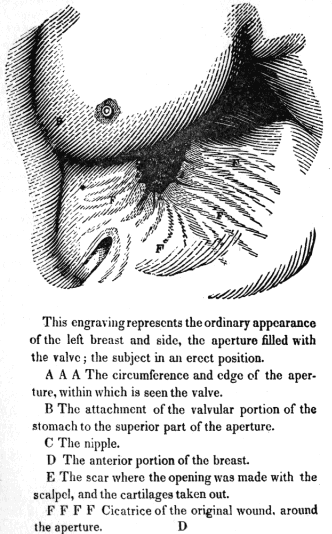Army physician William Beaumont was stationed at Fort Mackinac on Mackinac Island in Michigan in the early 1820s, when it existed to protect the interests of the American Fur Company. The fort became the refuge for a wounded 19-year-old French-Canadian fur trader named Alexis St. Martin when a shotgun went off by accident in the American Fur Company store and duck shot tore into his abdomen at close range June 6th, 1822.
That accident is key to much of our early knowledge about the workings of the digestive system, say speakers at the Experimental Biology 2013 meeting.
St. Martin's wound was serious. His stomach was perforated, several of his ribs were broken, and the shot blew off several muscle fragments. No one expected St. Martin to survive, but he did. Over the next year he healed but the skin around the wound fused to the hole in his stomach, leaving a permanent opening - a gastric fistula.
Food on Strings
"As Beaumont tended to St. Martin over the next three years, he realized that this was really a serendipitous event," says Jay Dean, Ph.D., of the University of South Florida, who studies the nerve cells that control heart rate and breathing and an amateur historian . "It dawned on him that there could be a research opportunity in this."
At the time, Dean explains, not much was known about digestion. To gain insight about this vital function, Beaumont performed a series of 238 experiments on St. Martin intermittently over an eight-year period. In all, experiments were conducted at four different rustic military outposts spanning the unsettled Great Lakes region to the East Coast.

A graphic from Beaumont's book. Link: University of Houston.
Twice, Beaumont had to convince the reluctant St. Martin to return from Canada to his frontier lab to continue the experiments. Many of these experiments involved inserting bits of different foods tied to strings through the hole in St. Martin's stomach, pulling them out periodically to observe digestion. Beaumont also removed gastric juice, examining it to better understand its nature.
Beaumont became the "Father of Gastric Physiology" and his observations became the book "Experiments and Observations on the Gastric Juice and the Physiology of Digestion" in 1833 and formed the basis of much of the early knowledge on digestion. Many of his observations have proven true with today's more sophisticated research techniques, Dean says.
For example, Beaumont discovered that hydrochloric acid is the main chemical responsible for breaking down food. He proposed the existence of a second important digestive chemical, which scientists now know is the enzyme pepsin. His experiments "digesting" food in a cup with St. Martin's extracted gastric juices showed that digestion is a chemical process, not merely a mechanical one caused by stomach muscle movement. His work also provided insights on how emotions, temperature, and physical activity can affect digestion.
From performing such intensive investigation in America's early days, Beaumont is now recognized as America's first physiologist, Dean says. Today, numerous hospitals are named after this physician-scientist.
Despite St. Martin's unusual wound - it never healed - he outlived Beaumont (who died in 1853) and fathered numerous children before dying at age 83.
Much of Beaumont's success relied on seizing an unexpected break, Dean says. "St. Martin ended up becoming Beaumont's living laboratory," Dean adds. "He recognized an opportunity that hadn't been planned on and exploited it to gain important knowledge, something good scientists often do today."
Today, a number of institutions are named after Beaumont, like the William Beaumont Army Medical Center at Ft. Bliss.






Comments